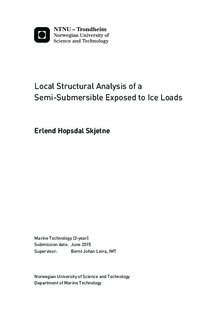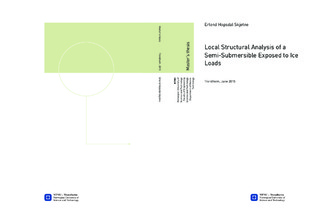| dc.description.abstract | The subject of deep sea drilling in the Arctic is now more relevant than ever. The environment in Arctic offshore areas can be extremely harsh and the structures operating there will have to be designed accordingly.
In this thesis the main objective is to investigate the structural response of the ice belt of a fourlegged semi-submersible drilling unit due to local ice loads. The design of the ice belt is based on drawings of the existing semi-submersible Deepsea Stavanger. This platform is not ice classed, so some modifications have been made to the original design.
The first part of the thesis is a literature review that gives an introduction to the subject of ice, from an engineering point of view, in form of a summary on different types of floating ice, ice properties and ice mechanics. Also, a study on ice loads has been conducted, with emphasis on local loads. This includes aspects of ice loads that should be considered and relevant load formulations for the semi-submersible platform. The last part of the literature review is about local strength requirements, and the Finite Element Method and how it is implemented in Abaqus.
The second part consists of the study of the ice belt, exposed to local ice loads. The study has been conducted by use of the finite element computer software Abaqus. The requirements for ice class PC4 from IACS s requirements concerning POLAR CLASS have been applied to the
outer shell and stiffeners of the ice belt, in order to ensure that it is strengthened for ice action. A convergence check has been performed in order to determine what element type and size that was feasible to conduct the analyses with. It was found that the S4R elements with mesh size 100 mm may give non-conservative stresses, however, it was used anyway in order to limit the required computational time.
Two types of nonlinear static analyses of the ice belt have been performed; one where structure has been exposed to ISO 19906 s local pressure for thick, massive ice features which does not account for ice classes. And one capacity check with steadily increasing loads. The aim of these types of analyses, respectively, was to check if the structure could withstand the ISO load without yielding. And to find out where on the structure and at what load magnitudes the maximum stresses reach yield and ultimate material stress. For each type of analysis several cases with different loading was investigated.
The main findings from the analyses that consider the ISO load are that yielding occurs in the structure for most of the different cases. The yielding occurs to a large extent, especially when the part of structure that has the weakest stringer structure is loaded. The results from the analyses that consider the capacity show that the largest stresses occurs in the stringer for all the different cases, even though the applied loads act over the design load patches for plates, stiffeners or bulkheads. This shows that the stringer is the weak spot of the model in the analyses performed.
The stringer, which consists of plates, stiffeners and brackets, is neither configured nor
dimensioned for ice loads. This is reflected by the results in terms of its high response. The results also show that the plates, stiffeners and bulkheads have lower response, and do not yield, when exposed to the ISO load in the areas where the stringer structure is stiff. By that it can be seen that the outer hull structure does not have to be strengthened further, in order to withstand the local ISO load, as long as the stringer is sufficiently stiff. | |

